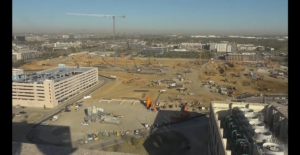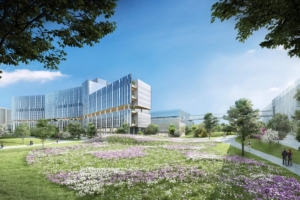How A Private Nonprofit And A Public University Are Building A $5 Billion Pediatric Campus
What was once the site of the Bass Administrative Building in Dallas’ Southwestern Medical District is now home to the early stages of a monumental healthcare project: the largest pediatric campus in the U.S. to be built from the ground up.

The first tower crane rises above the construction site of the Children’s Health and UTSW pediatric campus. (PHOTO CREDIT: Children’s Health)
Tower cranes rise above the site, signaling the transformation underway—one that promises to blend cutting-edge medical innovation with natural, healing environments.
The future pediatric hospital, recently named Moody Children’s Hospital following a landmark billion-dollar donation, is part of a larger 31.6-acre development. Two other major gifts of $100 million each have fueled momentum since the project’s official announcement. Upon completion in 2031, the expansive campus will be connected to Clements University Hospital via a 14,000-square-foot elevated skyway over Harry Hines Boulevard and will include administrative buildings, expansive green spaces, and high-capacity clinical facilities.
The campus will feature:
- 4.7 million square feet of new construction
- Three patient towers (two 12-story and one 8-story)
- 552 inpatient beds
- A 253,000-square-foot outpatient facility with 96 exam rooms
- Over 2 million square feet of underground parking with more than 5,000 spaces

(RENDERING CREDIT: Children’s Health)
Construction began in October, and by the end of this month, the team expects to complete pier drilling for the towers. Design and construction specifications—known as work packages—are being finalized and will define the interior features of each building. These will be completed by year’s end, according to Bob Feldbauer, Chief Facilities and Real Estate Development Officer at Children’s Health.
To manage this complex public-private initiative, UT Southwestern Medical Center (a state-run university) and Children’s Health (a private nonprofit pediatric health system) established a joint nonprofit called Pediatric Health Management Services. This organization oversees the project’s coordination and decision-making, ensuring both entities remain aligned throughout development.
The new campus is not only about increasing capacity; it’s about reimagining the pediatric care environment. One major enhancement is the addition of green space—something notably lacking at the current hospital. A central courtyard, Pogue Park, named in recognition of the Pogue family’s $100 million gift, will provide a calming, accessible space for patients and families.
Sustainability is another cornerstone of the design. The campus aims to achieve LEED Gold certification, a rare accomplishment in healthcare construction. This commitment extends beyond the hospital grounds, aligning with the Texas Trees Foundation’s efforts to reduce the heat island effect in the Southwestern Medical District—currently the city’s largest.
“Green space, trails, and bike networks not only enhance walkability but also support social connection and mental well-being,” said David Whitley of DRW Planning Studio, the project’s lead planning consultant.
Other notable features include:
- 13 playrooms for music, art, and academic programs
- 8 rehabilitation and therapy gyms
- 2 retail pharmacies
- A relocated Seacrest Studios
- A spacious, modern dining facility with unique food options not available at the existing hospital
- A private dining room where families can celebrate special moments such as birthdays or graduations
Though completion is still several years away, the thermal energy plant will be operational by late 2028 to ensure buildings are ready for occupancy as they finish. Parking and support facilities are set to open in 2029, followed by the main towers and outpatient buildings in 2030. The full campus is expected to be complete by 2031.
With the region’s pediatric population projected to double to 5 million by 2050, this campus is designed with long-term growth in mind.
“Children’s Health delivers some of the most advanced care in the nation for complex pediatric cases,” Feldbauer said. “This campus is built to serve generations—planned to meet the needs of the next 80 years and beyond.”
Source: D CEO Magazine
For more information contact us:
954.346.8200 x 201




